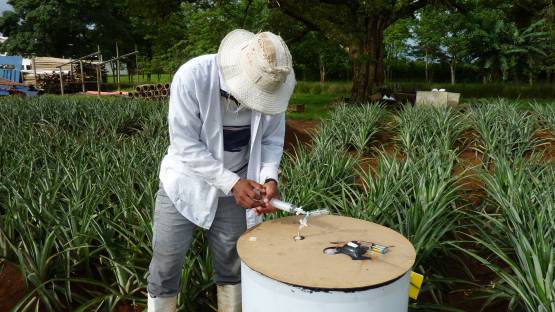Climate change is a global challenge. New techniques for measuring greenhouse gases (GHGs) from agriculture as well as mitigation and sequestration of carbon (C) using isotopic and related techniques were the tangible outcomes of a recently concluded IAEA research project to address climate change. Direct and indirect GHG emissions, such as carbon dioxide, methane, and nitrous oxide from agriculture and land use changes, contribute approximately 25 per cent to global anthropogenic GHG emissions.
Warming has caused several changes to our climate, including extreme weather events such as frequent droughts, floods, uneven distribution of rainfall, wildfires, and heatwaves, which are leading to crop failure, land degradation and depletion of soil fertility. Thus, the development and validation of climate-smart agriculture (CSA) practices are required to cope with the consequences of climate change for agriculture to ensure food security and enhance soil resilience, as well as to mitigate GHG emissions from agriculture.
The IAEA Coordinated Research Project (CRP) Minimizing Farming Impacts on Climate Change by Enhancing Carbon and Nitrogen Capture and Storage in Agro-Ecosystems focused on measuring GHG emissions for the better management of agricultural systems using isotopic and related techniques. By evaluating different CSA management options, the CRP generated a better understanding on how to enhance crop productivity, mitigate GHG emissions and increase the carbon storage capacity and resilience of soil. Experts from ten countries participated in this CRP: Brazil, Chile, China, Costa Rica, Estonia, Ethiopia, Germany, Iran, Pakistan and Spain.
Specific Research Objectives
The specific objectives of the CRP were to quantify N2O emissions to determine the emission factor of each participating country, increase crop productivity with a lower environmental footprint as compared to poor farming practices, to sequester carbon as well as to strengthen the capacity of the participating countries in using the isotopic technique of 15N to better understand microbial N2O production and nitrogen management.
Global impact
Ran in cooperation with the Food and Agriculture Organization of the United Nations (FAO), through the Joint FAO/IAEA Centre of Nuclear Techniques in Food and Agriculture, the project generated new knowledge and techniques for GHG measurement, as well as tangible results on GHG mitigation, adaptation and carbon sequestration using isotopic and related techniques. Furthermore, the researchers identified two new microbial processes for N2O production, opening the way to further N2O emission reductions from agriculture. This is particularly relevant, as N2O is about 300 times as potent as CO2 at heating the atmosphere. In addition, a new method for the monitoring of ammonia (NH3) emissions from agriculture was developed to help global efforts to reduce harmful air pollution as well as conserve nitrogen. The method is based on a simple device, that costs less than US $1. This CRP also helps to identify CSA practices that increase crop production by strengthening the countries’ capacities in using the 15N technique.
The project significantly contributed to a better understanding of climate change adaptation and mitigation for the participating countries. For the first time, Brazil, Chile, Costa Rica, Iran and Pakistan reported their GHG emission factor from agriculture. Climate-smart agriculture practices assessed in this CRP led to a significant improvement in crop production with a 50 per cent reduction in GHGs. Six master’s and four PhD students in Brazil, China, Costa Rica, Ethiopia, Pakistan and Germany completed their studies during the CRP. Part of this work was published here. In total, 34 papers have been published, including ten in a special issue of the Pedosphere Journal. In addition, a dedicated book, entitled Measuring Emission of Agricultural Greenhouse Gases and Developing Mitigation Options Using Nuclear and Related Techniques, published by Springer in February 2021, provided protocols, methodologies and standard operating procedures and mitigation options.
Relevance
Nuclear techniques play an essential role in the evaluation of management options used in CSA. Basic scientific methods related to the use of nuclear techniques enable the quantification of the effects that management options have on the dynamics of nitrogen and C in agricultural systems, elements which connect plants, soil, and the atmosphere. Nuclear techniques are the only precise measurement option to evaluate CSA practices, both in terms of the effect on C storage in soil, and the release of GHGs.
The output of this CRP on reducing GHG emissions in agriculture was discussed at the 2018 IAEA Scientific Forum and was featured in the 2018 IAEA Bulletin, Nuclear Technology for Climate: mitigation, monitoring and adaptation.
Several IAEA Technical Cooperation projects including RAS5083, COS5033, COS5035, PAK5051 and CHI0019 have been developed as a result of this CRP, which ran from 2014 to 2019.





